-

人教版高中英语必修4Theme parks说课稿3篇
The oldest and the most popular park in the worldenjoy the exciting activities thereget close to the life-size cartoon characters like Mickey Mouse and Donald Duck Step 3 Pre-reading1.What do you suppose a theme park is ?2.What do you think you can see in a theme park?(1.It is a kind of amusement park which has a certain theme – that the whole park is based on. 2.buildings, castles, statues, rare animals and birds, and so on.) Step 4 Reading ----- Theme Parks –---- Fun and More Than Fun1.Predict : Read the title and the pictures on P. 34 and PredictWhat is the meaning of the title “Theme Park – Fun and more than fun”?(The title means that theme parks are fun to visit, but that they can also be educational and can offer useful information.)2.Skimming Fast read and answer:What activities can we take in a theme park?Amusement park: Bumper car Merry-go-round slide bungee jumping Free-fall rides Horror films Pirate ship Ferris wheel roller coaster3.Scanning Read again and you will find various theme parks are mentioned in the passage . Then what are they ?Theme parks: Sports theme park History theme park Culture theme park Marine or Ocean theme Park Future park Science theme park Disneyland4.Careful reading and find the main idea of each paragraph:THEME PARKS---- entertaining/ educationalPara.1 Traditional parks are places to go for relaxation and to have time away from our busy lives.Para.2 Theme parks are different They’re large and full of things to do, see and buy.Para.3 Theme parks are built around a single idea or theme. One example is a sports park.Para.4 Another kind of theme park is historical more and cultural and can be educational.Para.5 Disneylandwas the first theme park. It is based on the fantasy life and characters of Disney’s films.Para.6 Some examples of educational theme parks include sea world parks and science parks.

人教版高中英语必修4Working The Land说课稿3篇
Knowledge objectives:(1) to make Ss grasp the usage of words, expressions and sentence structures: statistics, struggle, thanks to, rid of, some patterns for persuasion, the “ing” form as subject and object;(2)to use learnt knowledge to persuade sb.Ability objectives:(1) to develop Ss’ reading skills(skimming, scanning, word guessing);(2) to improve Ss’ speaking, communicating and cooperating skills.Emotional objectives:to make Ss know the contribution of Yuan,and learn his spirit and his simple life time.Teaching important and difficult points:(1) some words, expressions and sentence structures mentioned above;(2)the content of the text;(3)training their reading and speaking skills.Teaching methods: CLT, TBLT,QT.Learning strategies: CLS, QLS, TBLS.Teaching procedures:Step 1 lead-in: (1) teacher plays a piece of recent news from CCTV about the harvest of the super hybrid rice, and ask students whether they know Yuan or not, and talk about him and his contribution.(2)Brain storm: let Ss describe Yuan in their minds including his appearance, his living condition and so on.Step 2 fast reading tasks:(1)teacher introduces Yuan and super hybrid rice(2)make Ss read the text as fast as possible with questions. Such as: what’s the general ideaof this passage? What’s Yuan’ dream? (skimming and scanning skill)Step 3 intensive reading tasks(1)let Ss read the text silently, find topic sentence of each paragraph and draw the difficult sentences and the knowledge what they don’t understand.(words guessing)(2)teacher and Ss talk about the important words, expressions and sentences together, and ask Ss to retell the content of the text.(summarizing and paraphrasing)(3)teacher summarize this part.(4) read again following the courseware.

人教版高中英语必修3The million pound bank note说课稿3篇
在接下来的细读环节,我套用了高考对阅读理解的考查方式设置了5个问题,分别为三个推理判断题,一个细节题和一个主旨大意题。学生需要对文章的内容进行分析、归纳、推理、猜测等高级思维活动才能做出正确的回答。【设计意图】这一过程是对学生进行细读的训练,培养学生获取特定信息和挖掘文章深层次信息的能力。第三环节:Intensive-reading (精读) 15′第三个环节精读,既是最重要的环节,也是突破本课重难点的关键。首先,让学生思考剧本中人物看到百万英镑前后的态度发生了怎样的变化。其次,让学生仔细阅读文章,找出可以表现人物态度变化的具体的语言和动作。最后,让学生总结人物的态度发生变化的根本原因是什么,从而引出Money Talks, 供学生思考。【设计意图】通过一系列的活动培养学生学习从人物的语言和动作探究人物的心理,使学生进一步体会戏剧语言的魅力,从而对文章背后所反映的社会问题进行思考,也为下一步的讨论环节做好铺垫。

人教版高中英语必修5First aid说课稿6篇
In this class, I have 3 teaching aims, that is, knowledge aims, ability aims and emotion aims.1) Knowledge-Teach students new words and expressions, such as temporary, bleed,sprain choke, first aid, fall ill and so on.-Enable students to have a better understanding for some basic knowledge of first aid.2) Ability-Train students’ speaking, reading and writing abilities by different teaching activities, such as skimming, comprehending, team work, role play, retelling and writing.-Develop students’ reading strategy on how to move general idea to specific information.3) Emotion-Promote students’ awareness of giving first aid.- Cultivate students’ creativities.Then let’s come to my teaching methods and activities.III. Teaching methods and activities:To achieve different teaching aims, various kinds of teaching methods and activities will be adopted throughout this period, such as TBL (task-based learning), skimming, team work, brainstorm and others, which can offer students opportunities to fulfill tasks in which they can use language to achieve a specific outcome.IV. Teaching aids:Computer and blackboardV. Teaching important points:1) Make students have a clear mind for the structure of the text.2) Help students understand the theme of the text.VI. Teaching difficulties:1) So many new words may affect students’ understanding.2) How to get students to know about the functions of the skin and thecauses, characteristics and treatments for different degree burns,and the knowledge about giving first aid. VII. Blackboard design:

人教版高中英语必修5Great scientists说课稿4篇
通过写文章梗概,培养学生综合运用语言的能力,学习用恰当的英语描述科学家的故事。这是本课的教学难点。教师可以使用完形填空的方式来帮助学生整理语篇,从而来降低难度。本课的教学重点的突破方法是:在阅读前,让学生初步了解得出科学观点所需要的基本程序,从而轻松而自然地导入文章的阅读;在阅读过程中,由易到难设计快速阅读和精读的问题,层层推进各种阅读活动,让学生对阅读内容从整体感知到细节理解,最后深层读懂整篇文章,同时加强阅读策略的指导,让每个学生都主动参与课堂教学活动,最终达到提高阅读能力的目的。Step 4 Post-readingGroup Activities四人小组共同合作,在老师的适当指导下,就以下2个问题展开讨论,让学生就所知、所学、所感和所想融入话题,然后抽若干同学代表作小组发言。1. What do you think about John Snow, and what should we learn from him?2. Cholera was 19th century disease, which two diseases are similar to cholera today? Why?

人教版高中英语必修5Life in the Future说课稿5篇
Good afternoon, everyone. It’s my great pleasure to be here sharing my lesson with you. The content of my lesson is Senior English for China Book5 Unit 3 Life in the Future. I’ll be ready to begin this lesson from six parts: Analysis of the teaching material, Analysis of the students, Teaching aims and important and difficult points, Teaching methods and aids, Teaching procedures, and Blackboard design. First, let me talk about the teaching material.Part 1 Analysis of the Teaching Material:This unit is about what human beings’ life will be like in about one thousand years. By studying of this unit, we’ll Enable the students to know the changes in humans’ life and some new inventions bringing about the change and develop the interest in science. This lesson plays an important part in the English teaching in this unit. This is an important lesson in Book Five. From this lesson, it starts asking the Ss to grasp contents of each passage. Therefore, this lesson is in the important position of the teaching material. If the Ss can learn it well, it will be helpful to make the Ss learn the rest of this unit.Part 2 Analysis of the SsAs Senior2 Ss, they are at different levels of English fluency, some of them have lost interest in English. So during the lesson, I arrange a variety of activities to let all of them join in to attract their interest and let them be confident and taste the joy of success.

人教版高中英语必修5The United Kingdom说课稿4篇
Teaching Aims:Knowledge 1. Get the students to learn the useful new words and expressions in this section. Aims:2. Let the students learn about how the UK was formed and the four groups of invaders.1. Develop students’ reading ability and let them learn different Ability reading skills. Aims:2. Enable students to learn to talk about the United Kingdom and the Union Jack Emotional 1. Let students know more about the UK2. Develop students’ sense of cooperative learning Aims:Teaching Important Points:1. Let the students learn about the countries of the United Kingdom and the Union Jack2. Get the students to read the passage and know about how the UK was formed and the four groups of invaders.3. Have the students learn different reading skills.Teaching Difficult Ponts:1. Develop students’ reading ability.2. Enable students to talk about the United Kingdom and the Union Jack.3. Let students learn how the UK was formed geographically and historically.Teaching Methods:Showing pictures, asking, exercising, listening, reading etc.Teaching Aids:A computer,a projector and a blackboard.Teaching Procedures: 1) Show a map of the world, ask students the following questions:Where is the UK?What’s the full name of the UK?2) Ask the students work in pairs to do the quiz on Page 9.Do you want to test how many things you know about the United Kingdom? Let’s have a small test.Using the map on P9, students answer the following questions:?How many countries does the UK consist of? What are they??England is divided into three main areas. Do you know what they are? 1) Scanning (10Minutes )Let the students hold the questions asked in pre-reading and read the passagequickly and then let them do the following exercise.Join lines to the right answer.
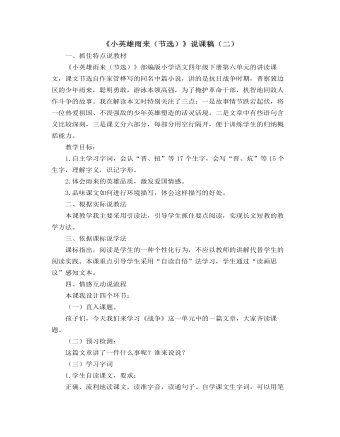
部编人教版四年级下册《小英雄雨来》说课稿(二)
一、抓住特点说教材《小英雄雨来(节选)》部编版小学语文四年级下册第六单元的讲读课文,课文节选自作家管桦写的同名中篇小说,讲的是抗日战争时期,晋察冀边区的少年雨来,聪明勇敢,游泳本领高强,为了掩护革命干部,机智地同敌人作斗争的故事。我在解读本文时特别关注了三点:一是故事情节跌宕起伏,将一位热爱祖国、不畏强敌的少年英雄塑造的活灵活现。二是文章中有些语句含义比较深刻,三是课文分六部分,每部分用空行隔开,便于训练学生的归纳概括能力。教学目标:1.自主学习字词,会认“晋、扭”等17个生字,会写“晋、炕”等15个生字,理解字义,识记字形。2.体会雨来的英雄品质,激发爱国情感。3.品味课文如何进行环境描写,体会这样描写的好处。
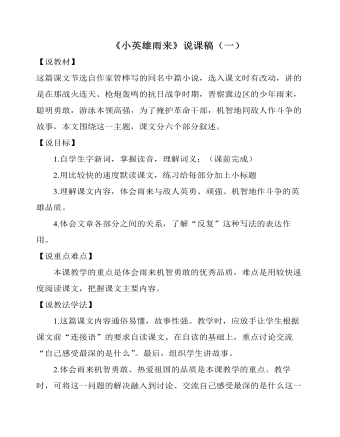
部编人教版四年级下册《小英雄雨来》说课稿(一)
【说教材】这篇课文节选自作家管桦写的同名中篇小说,选入课文时有改动,讲的是在那战火连天、枪炮轰鸣的抗日战争时期,晋察冀边区的少年雨来,聪明勇敢,游泳本领高强,为了掩护革命干部,机智地同敌人作斗争的故事,本文围绕这一主题,课文分六个部分叙述。【说目标】1.自学生字新词,掌握读音,理解词义;(课前完成)2.用比较快的速度默读课文,练习给每部分加上小标题3.理解课文内容,体会雨来与敌人英勇、顽强、机智地作斗争的英雄品质。
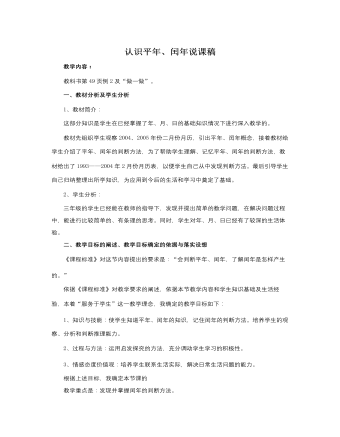
人教版新课标小学数学三年级下册认识平年、闰年说课稿
教学反思:本节课的重点在于使学生积极主动地参与知识的发生,发展过程。从而提高了学生探索、发现、解决问题及创新的能力。1、师生角色的定位:本节课很好地体现了以学生为主体的教育理念,充分体现出教师是教学的组织者、引导者和能起到促进作用的参与者的角色。2、教学策略的灵活性:这节课中先后使用了观察到游戏、游戏到探究新,又由探究新知到拓展延伸的灵活转化,使知识由浅到深的被学生所吸收,做到了循序渐进的教学原则。3、巩固练习的合理设计:本课练习的设计注重了题型的基础性、发散性、及拓展延伸性,习题的层次性、使班各个层次的学生都能参与到学习活动中,都能充分体会到学习给自己带来的成就感。激发了学习动机,促进了学生的求知欲,从而也提高了课堂教学的效率。
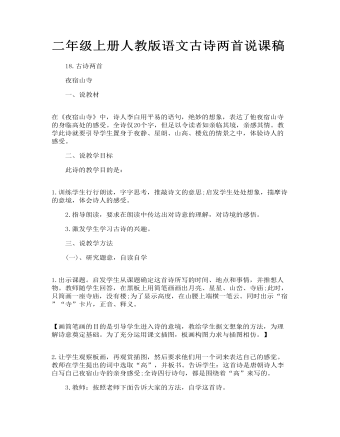
二年级上册人教版语文古诗两首说课稿
二、说教学目标 此诗的教学目的是: 1.训练学生行行朗读,字字思考,推敲诗文的意思;启发学生处处想象,揣摩诗的意境,体会诗人的感受。 2.指导朗读,要求在朗读中传达出对诗意的理解,对诗境的感悟。 3.激发学生学习古诗的兴趣。 三、说教学方法 (一)、研究题意,自读自学 1.出示课题。启发学生从课题确定这首诗所写的时间、地点和事情,并推想人物。教师随学生回答,在黑板上用简笔画画出月亮、星星、山峦、寺庙;此时,只简画一座寺庙,没有楼;为了显示高度,在山腰上端横一笔云。同时出示“宿”“寺”卡片,正音、释义。 【画简笔画的目的是引导学生进入诗的意境,教给学生据文想象的方法,为理解诗意奠定基础。为了充分运用课文插图,板画构图力求与插图相仿。】 2.让学生观察板画,再观赏插图,然后要求他们用一个词来表达自己的感觉。教师在学生提出的词中选取“高”,并板书。告诉学生:这首诗是唐朝诗人李白写自己夜宿山寺的亲身感受;全诗四行诗句,都是围绕着“高”来写的。
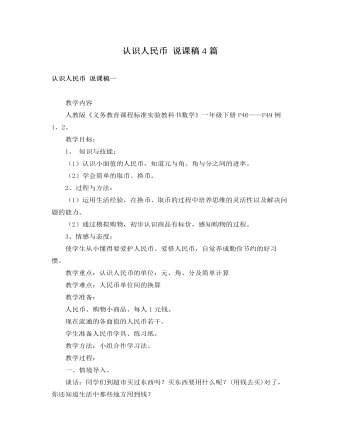
人教版新课标小学数学一年级下册认识人民币 说课稿4篇
一、说教材《认识人民币》是人教版小学数学一年级下册第五单元的第一课时的内容。本课是让学生认识各种面值的人民币,初步知道人民币的基本知识和如何使用人民币,提高社会实践能力;另一方面使学生加深对100以内数的概念的理解,体会数概念与现实生活的密切联系。二、说教学目标1、学生能够正确的认识各种面值的人民币,知道人民币的单位元、角、分,知道1元=10角。 2、能较熟练地辨认各种面值的人民币。 3、感受数学与实际生活的密切联系。。教学重点:认识各种面值的人民币,知道人民币的单位元、角、分,知道1元=10角。教学难点:人民币的等价兑换。三、说教法、学法在整个教学过程中采用小组合作交流的学习方式,为学生设计猜一猜,看钱、认钱,唱歌、分类等活动。
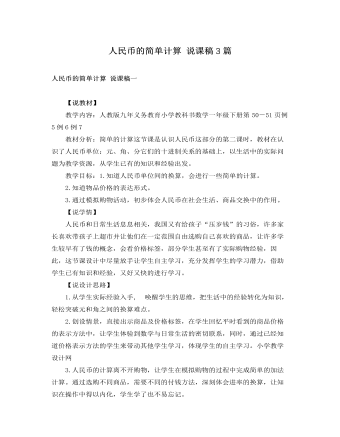
人教版新课标小学数学一年级下册人民币的简单计算 说课稿3篇
教学重难点:学会人民币单位间的换算和简单的加减法计算以及学会看物品价格的表示形式第三部分 设计意图1. 通过购物情景的创设,使课堂富有真实的生活气息。2. 为学生搭建知识的攀升阶梯,让学生经历数学知识的发展形成过程。3. 将所学知识应用现实生活中,解决实际问题。第四部分 教学过程一、创设情境,激趣导入。1.孩子们你们喜欢交朋友吗?(喜欢)在班级里谁是你的好朋友呀?(学生回答)你们喜欢我吗?我也想和你们做朋友。今天我还给同学们带来了一个新朋友?你们看它是谁?电脑出示米老鼠你们想和它做朋友吗?想和它做朋友上课就得好好表现,他们才愿意做你们的朋友.谁说一下,上课怎样做才是好好表现呢?(要专心听见,勇敢发言,)老师看看勇敢的你在哪里?
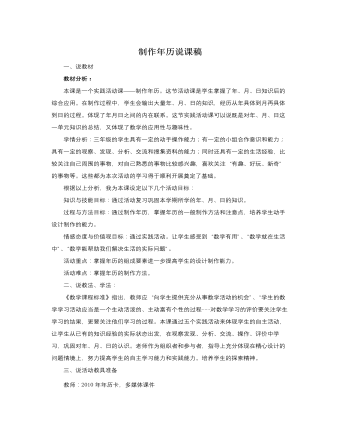
人教版新课标小学数学三年级下册制作年历说课稿
教材分析:本课是一个实践活动课——制作年历。这节活动课是学生掌握了年、月、日知识后的综合应用。在制作过程中,学生会输出大量年、月、日的知识,经历从年具体到月再具体到日的过程。体现了年月日之间的内在联系。这节实践活动课可以说既是对年、月、日这一单元知识的总结,又体现了数学的应用性与趣味性。学情分析:三年级的学生具有一定的动手操作能力;有一定的小组合作意识和能力;具有一定的观察、发现、分析、交流和搜集资料的能力;同时还具有一定的生活经验,比较关注自己周围的事物,对自己熟悉的事物比较感兴趣,喜欢关注“有趣、好玩、新奇”的事物等。这些都为本次活动的学习得于顺利开展奠定了基础。根据以上分析,我为本课设定以下几个活动目标:知识与技能目标:通过活动复习巩固本学期所学的年、月、日的知识。
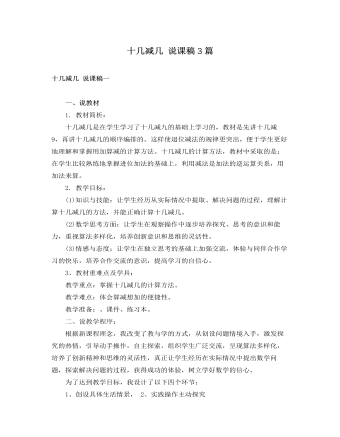
人教版新课标小学数学一年级下册十几减几 说课稿3篇
得到13-8=这个算式后,我让小朋友们想办法,“13-8怎么算?你是怎样想的?把你的想法告诉你小组的同学们。”由于我是用讲故事的形式引出这一问题的,因此在计算13-8时,小朋友们就被迫要自己想办法去计算,而不能光借助情境图去直接数出得数。这并不阻碍算法的多样化,相反更好地实现了算法多样化的目的,真正让学生成为了数学学习的主人。为了增加这堂课的趣味性,我有意将学生说出来的各种算法分别以他们的名字来命名,这样一来,学生兴趣盎然,都积极投入到了寻找算法的思考活动中来了。在寻求多样化的过程中,充分发挥了学生学习的主体性,培养了学生的创新精神,让每一个学生都能体验学习的成功。学生们在思考、讨论中可能会出现这样几种算法:
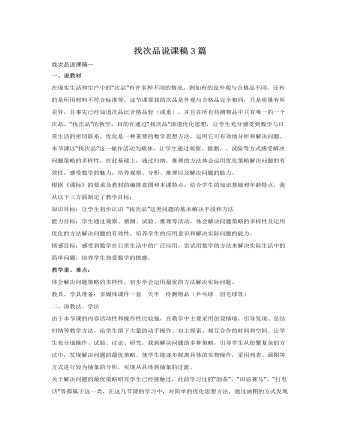
人教版新课标小学数学五年级下册找次品说课稿3篇
五、教学评价《数学课程标准》指出:“有效的数学学习活动不能单纯地依赖模仿和记忆,动手实践、自主探索与合作交流是学生学习数学的重要方式。”这节课的设计着力让学生通过参与有效的实际操作、观察比较来概括出“找次品”的最佳方案。把学生的学习定位在自主建构知识的基础上,建立了“猜想——验证——反思——运用”的教学模式。让学生体验解决问题策略的多样性及运用优化的方法解决问题的有效性。培养学生的自主性学习能力和创造性解决问题的能力。(一)创设情景通过身边生活实例,为学生创设问题情景,让数学问题生活化,一上课就吸引住学生的注意力,调动他们的探究兴趣,为后面的教学做好铺垫,使学生进入最佳的学习状态。让学生充分感受到数学与日常生活的密切联系。
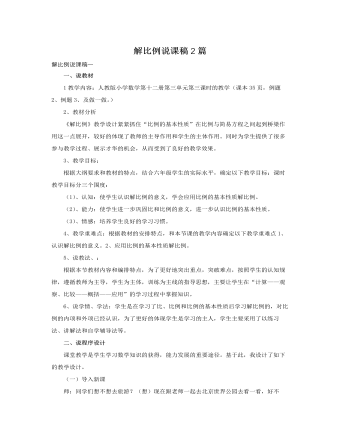
人教版新课标小学数学六年级下册解比例说课稿2篇
教学新课1.教学例2。出示例2。提问:你能用比例的基本性质来解比例,求出未知项x吗?自己先想一想,有没有办法做。再试着做做看。指名一人板演,其余学生做在练习本上。集体订正,让学生说说怎样想的,第一步的根据是什么,并向学生说明解比例的书写格式。2.教学例3。出示例题,让学生用比例形式读一读。让学生解答在自己的练习本上。指名口答解比例过程,老师板书。让学生说一说解比例的方法。指出:解比例一般按比例的基本性质写出积相等的式子,再求未知数x。3.教学“试一试”。提问已知数都是怎样的数。让学生自己解答。学生口答是怎样做的,老师板书。4.小结方法。提问:你认为根据比例的基本性质要怎样解比例?巩固练习1.做“练一练”。指名四人板演。其余学生分两组,每组两道题,做在练习本上。
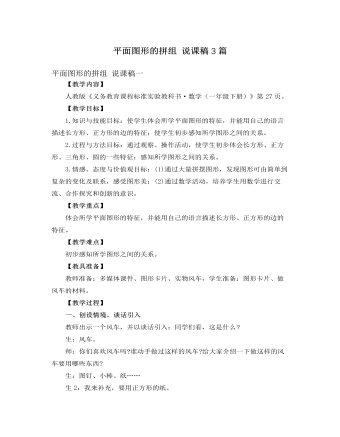
人教版新课标小学数学一年级下册平面图形的拼组 说课稿3篇
第三板块:夯实基础 发展技能检测是实施课堂优化教学的重要手段。因此,本节课的第三板块我设计了课堂目标检测,检测中以闯关形式设计了五个活动:即第一关:快乐填一填。第二关:动手剪一剪。第三关:用心拼一拼。第四关:仔细数一数。第五关:神奇拼一拼。检测中前三关,重抓基础知识的落实,后两关注重学生技能的培养,以及用数学的能力,符合低年级儿童年龄特点,我充分利用了学生争强好胜,乐于竞争的心理,以争夺智慧星的小组合作赛形式进行检测。既提升了学生自主强化知识的兴趣,又培养了学生集体主义观念。以上是我对《平面图形的拼组》一课设计理念的剖析与阐述,当然,教学是一门缺憾的艺术。所以,不足之处还请各位前辈提出宝贵意见!谢谢大家!
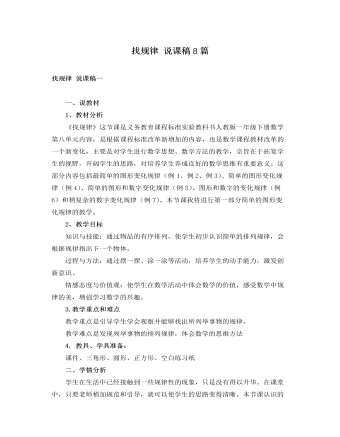
人教版新课标小学数学一年级下册找规律 说课稿8篇
刚才大家只用了几个简单的图形就摆出了这么多不同的的规律,可见数学真奇妙!认真观察这些作品,他们贴得都有规律吗?谁有问题想问大家?生可能问:看到这些规律,你有什么想说的吗?谁能看出黑板上摆的第一条规律?第三条继续摆,下一个是什么图形?最后一条该怎么分组,规律就看得特别清楚了?这些规律有什么相同和不同的地方?……师生共同总结出: 今天我们研究的规律都是有关图形的规律;摆放的图形的颜色、方向、形状以及个数的变化都可出现一些有趣的规律。聪明的设计师都习惯运用规律来布置我们周围的环境,我们也可以应用规律来美化我们的生活。六、反思拓展,总结全课师:这节课快上完了,评价一下自己吧.这节课你快乐吗?你会了吗?有没有遗憾?生活中有了规律就有了美,希望同学们课后继续去发现美,创造美,让我们的生活更加多姿多彩!
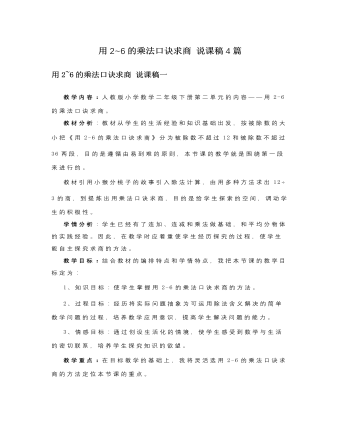
人教版新课标小学数学二年级下册用2~6的乘法口诀求商说课稿4篇
一、创设情境,导入新课教师边放课件边讲故事):今天老师给你们讲一个“猴妈妈分桃”的故事。有一天,一群小猴到山下去玩,走着走着,看到一棵桃树上结满了又大又红的桃,就摘了很多。回家后,猴妈妈看到小猴们拿了这么多桃回来,可高兴了,说:“妈妈分桃给你们吃。”二、合作交流,探索新知1、动手操作,探究方法(1)提出问题。师:小猴摘了多少个桃?准备每只小猴分3个,可分给几只猴子?(板书:12个桃,每只小猴分3个,可以分给几只小猴?)(2)学生列式:12÷3=(3)分一分学生小组合作,动手分一分。(可以用其他的物体代替)(4)说一说分的过程可能有以下几种:第一种:先分给第一只小猴3个桃,再分给第二只小猴3个桃,然后给第3只小猴3个桃,最后3个桃正好分给第四只小猴。……12个桃可分4只猴子。

